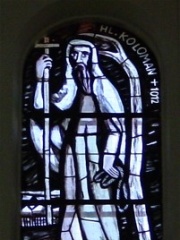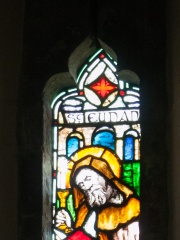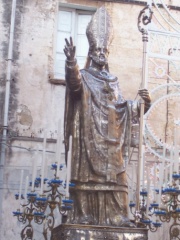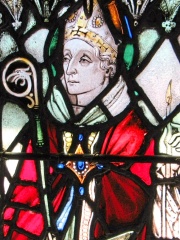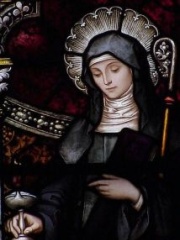
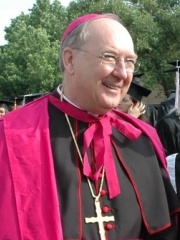
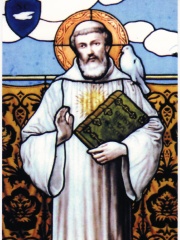
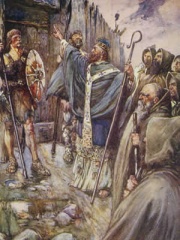
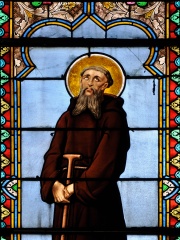
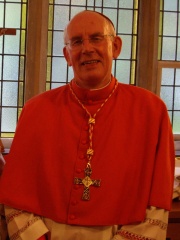
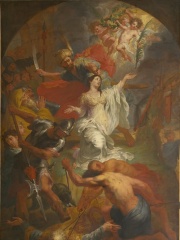
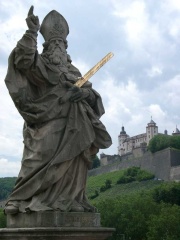
The Most Famous
RELIGIOUS FIGURES from Ireland
This page contains a list of the greatest Irish Religious Figures. The pantheon dataset contains 3,187 Religious Figures, 21 of which were born in Ireland. This makes Ireland the birth place of the 26th most number of Religious Figures behind Austria, and Portugal.
Top 10
The following people are considered by Pantheon to be the top 10 most legendary Irish Religious Figures of all time. This list of famous Irish Religious Figures is sorted by HPI (Historical Popularity Index), a metric that aggregates information on a biography's online popularity. Visit the rankings page to view the entire list of Irish Religious Figures.

1. Brigid of Kildare (451 - 525)
With an HPI of 75.96, Brigid of Kildare is the most famous Irish Religious Figure. Her biography has been translated into 34 different languages on wikipedia.
Saint Brigid of Kildare or Saint Brigid of Ireland (Irish: Naomh Bríd; Classical Irish: Brighid; Latin: Brigida; c. 451 – c. 525) is the patroness saint (or 'mother saint') of Ireland, and one of its three national saints along with Patrick and Columba. According to medieval Irish hagiographies, she was an abbess who founded the important abbey of Kildare (Cill Dara), as well as several other convents of nuns. There are few documented historical facts about her, and her hagiographies are mainly anecdotes and miracle tales, some of which are rooted in pagan folklore. They say Brigid was the daughter of an Irish clan chief and an enslaved Christian woman, and was fostered in a druid's household before becoming a consecrated virgin. She is patroness of many things, including poetry, learning, healing, protection, blacksmithing, livestock, and dairy production. In her honour, a perpetual fire was kept burning at Kildare for centuries. Some historians suggest that Brigid is a Christianisation of the Celtic goddess Brigid. The saint's feast day is 1 February, and traditionally it involves weaving Brigid's crosses and many other folk customs. It was originally a pre-Christian festival called Imbolc, marking the beginning of spring. Since 2023, it has been a public holiday in the Republic of Ireland. This feast day is shared by Dar Lugdach, who tradition says was her student, close companion, and successor.

2. Kevin Farrell (b. 1947)
With an HPI of 72.27, Kevin Farrell is the 2nd most famous Irish Religious Figure. Her biography has been translated into 30 different languages.
Kevin Joseph Farrell (born 2 September 1947) is an Irish-born American Catholic prelate who has served as the prefect of the Dicastery for the Laity, Family and Life since 2016, Camerlengo of the Holy Roman Church since 2019, and president of the Supreme Court of Vatican City since 2024. He served as the regent of Vatican City after the death of Pope Francis on 21 April 2025, and held these interim duties until Leo XIV was elected as pope on 8 May. After his ordination in 1978, Farrell served as a chaplain and university teacher for several years in Mexico and worked in the United States from 1984 to 2016. He was an auxiliary bishop of the Archdiocese of Washington from 2002 to 2007 and Bishop of Dallas from 2007 to 2017. He was made a cardinal in 2016.

3. Columbanus (540 - 615)
With an HPI of 71.59, Columbanus is the 3rd most famous Irish Religious Figure. His biography has been translated into 40 different languages.
Saint Columbanus (Irish: Columbán; 543 – 21 November 615) was an Irish missionary notable for founding a number of monasteries after 590 in the Frankish and Lombard kingdoms, most notably Luxeuil Abbey in present-day France and Bobbio Abbey in present-day Italy. Columbanus taught an Irish monastic rule and penitential practices for those repenting of sins, which emphasised private confession to a priest, followed by penances imposed by the priest in reparation for the sins. Columbanus is one of the earliest identifiable Hiberno-Latin writers.

4. Columba (521 - 597)
With an HPI of 67.83, Columba is the 4th most famous Irish Religious Figure. His biography has been translated into 53 different languages.
Columba () or Colmcille (7 December 521 – 9 June 597 AD) was an Irish abbot and missionary evangelist credited with spreading Christianity in what is today Scotland at the start of the Hiberno-Scottish mission. He founded the important abbey on Iona, which became a dominant religious and political institution in the region for centuries. He is the patron saint of Derry. He was highly regarded by both the Gaels of Dál Riata and the Picts, and is remembered today as a Catholic saint and one of the Twelve Apostles of Ireland. Columba studied under some of Ireland's most prominent church figures and founded several monasteries in the country. Around 563 AD he and his twelve companions crossed to Dunaverty near Southend, Argyll, in Kintyre before settling in Iona in Scotland, then part of the Ulster kingdom of Dál Riata, where they founded a new abbey as a base for spreading Christianity among the pagan Northern Pictish kingdoms. He remained active in Irish politics, though he spent most of the remainder of his life in Scotland. Three surviving early-medieval Latin hymns are attributed to him.
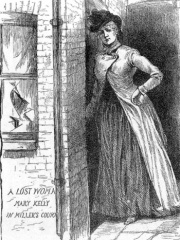
5. Mary Jane Kelly (1863 - 1888)
With an HPI of 64.73, Mary Jane Kelly is the 5th most famous Irish Religious Figure. Her biography has been translated into 24 different languages.
Mary Jane Kelly (c. 1863 – 9 November 1888), also known as Marie Jeanette Kelly, Fair Emma, Ginger, Dark Mary and Black Mary, is widely believed by scholars to have been the final victim of the notorious unidentified serial killer Jack the Ripper, who murdered at least five women in the Whitechapel and Spitalfields districts of London from late August to early November 1888. At the time of her death, Kelly was approximately 25 years old, working as a prostitute and living in relative poverty. Unlike the other four canonical Ripper victims—each of whom had been murdered outdoors and whose mutilations could have been committed within minutes—Kelly was murdered within the sparsely furnished single room she rented at 13 Miller's Court, affording her murderer an extensive period of time to eviscerate and mutilate her body. Kelly's body was by far the most extensively mutilated of the canonical victims, with her mutilations taking her murderer approximately two hours to perform.

6. Saint Fiacre (607 - 668)
With an HPI of 64.56, Saint Fiacre is the 6th most famous Irish Religious Figure. His biography has been translated into 19 different languages.
Fiacre (Irish: Fiachra, Latin: Fiacrius) is the name of three different Irish saints, the most famous of which is Fiacre of Breuil (c. AD 600 – 18 August 670), the priest, abbot, hermit, and gardener of the seventh century who was famous for his sanctity and skill in curing infirmities. He emigrated from his native Ireland to France, where he constructed for himself a hermitage together with a vegetable and herb garden, oratory, and hospice for travellers. He is the patron saint of gardeners and hemorrhoids.

7. Seán Brady (b. 1939)
With an HPI of 64.37, Seán Brady is the 7th most famous Irish Religious Figure. His biography has been translated into 24 different languages.
Seán Brady KGCHS (born 16 August 1939) is an Irish prelate who is a Cardinal of the Catholic Church. He was Roman Catholic Archbishop of Armagh and Roman Catholic Primate of All Ireland from 1996 until 2014. He was elevated to the rank of cardinal by Pope Benedict XVI in the consistory on 24 November 2007. He left office in 2014 and was succeeded by Eamon Martin, who had served as Coadjutor Archbishop of Armagh since 2013.

8. Dymphna (700 - 700)
With an HPI of 63.80, Dymphna is the 8th most famous Irish Religious Figure. Her biography has been translated into 23 different languages.
Dymphna (also Dimpna, Dymfna, Dimfna, Dympna and Dympha, Irish also Damhnait or Davnet) is a Christian saint honoured in Catholic and Eastern Orthodox traditions. According to tradition, she lived in the 7th century and was martyred by her father. The life of Saint Dymphna was first recorded in the 13th century by a canon of the Church of Aubert of Avranches at Cambrai, France. It was commissioned by Guiard of Laon, the Bishop of Cambrai (1238–1248).

9. Saint Kilian (640 - 689)
With an HPI of 62.90, Saint Kilian is the 9th most famous Irish Religious Figure. Her biography has been translated into 22 different languages.
Kilian, also spelled Cillian or Killian (or alternatively Irish: Cillín; Latin: Kilianus, original Gaelic form Ceallach), was an Irish missionary bishop and the Apostle of Franconia (now the northern part of Bavaria), where he began his labours in the latter half of the 7th century. His feast day is 8 July.
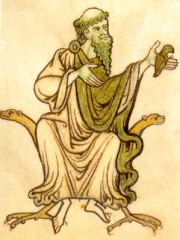
10. Kevin of Glendalough (498 - 618)
With an HPI of 61.62, Kevin of Glendalough is the 10th most famous Irish Religious Figure. His biography has been translated into 19 different languages.
Kevin (Modern Irish: Caoimhín; Old Irish: Cóemgen, Caemgen; Latinized Coemgenus; 498 (reputedly)–3 June 618) is an Irish saint, known as the founder and first abbot of Glendalough in County Wicklow, Ireland. His feast day is 3 June.
People
Pantheon has 21 people classified as Irish religious figures born between 451 and 1947. Of these 21, 2 (9.52%) of them are still alive today. The most famous living Irish religious figures include Kevin Farrell, and Seán Brady. The most famous deceased Irish religious figures include Brigid of Kildare, Columbanus, and Columba.
Living Irish Religious Figures
Go to all RankingsDeceased Irish Religious Figures
Go to all RankingsBrigid of Kildare
451 - 525
HPI: 75.96
Columbanus
540 - 615
HPI: 71.59
Columba
521 - 597
HPI: 67.83
Mary Jane Kelly
1863 - 1888
HPI: 64.73
Saint Fiacre
607 - 668
HPI: 64.56
Dymphna
700 - 700
HPI: 63.80
Saint Kilian
640 - 689
HPI: 62.90
Kevin of Glendalough
498 - 618
HPI: 61.62
Coloman of Stockerau
1000 - 1012
HPI: 59.88
Adomnán
624 - 704
HPI: 59.41
Catald
700 - 685
HPI: 58.52
Aidan of Lindisfarne
600 - 651
HPI: 58.48
Overlapping Lives
Which Religious Figures were alive at the same time? This visualization shows the lifespans of the 4 most globally memorable Religious Figures since 1700.

